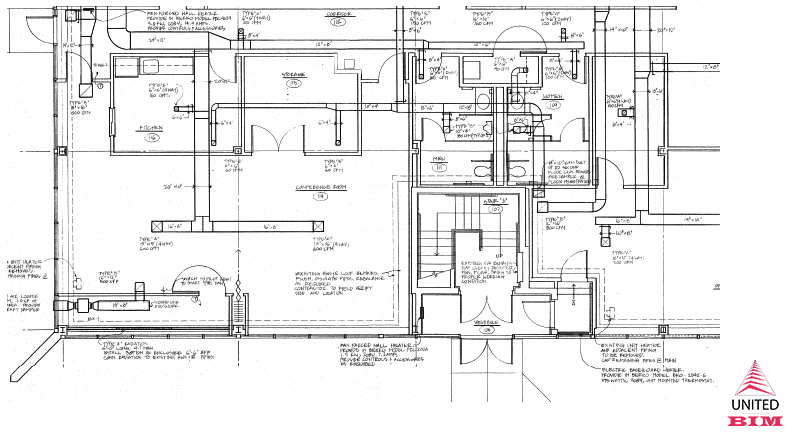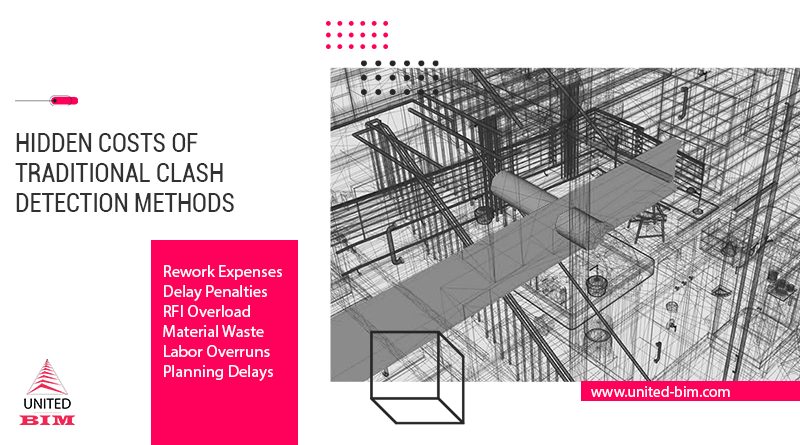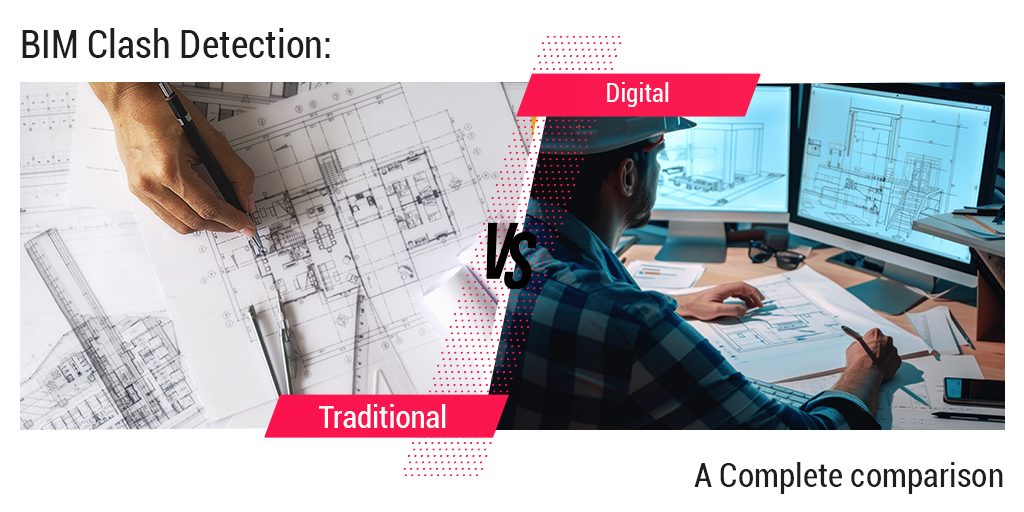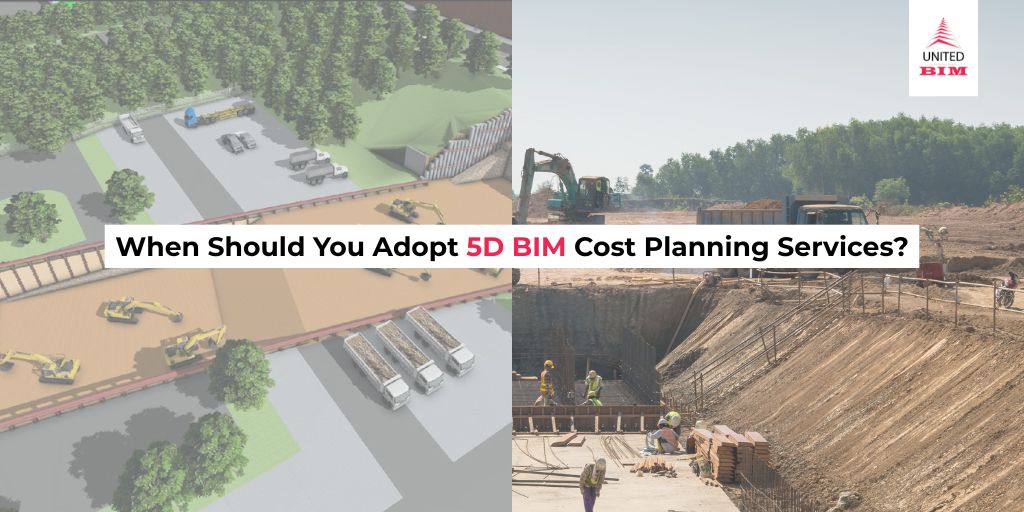Last updated on: April 16, 2025
Table of Contents
- Traditional Clash Detection: The Conventional Approach
- Challenges with Traditional Detection Method
- What is BIM Clash Detection?
- Advantages of Clash Detection using BIM technology
- Key Differences between Traditional and BIM Clash Detection
- Advantages of Clash Detection using BIM technology
- See How BIM Clash Detection Solved On-Site Conflicts in These Projects
- Parting Thoughts
- Choose accurate and reliable clash detection services.
Effective coordination is the backbone of any successful construction projects. Inconsistent design data, misaligned disciplines, and overlooked conflicts can result in costly rework and delays. Traditional coordination methods have been used for decades, relying on manual clash detection using 2D drawings and communication between teams. Most of the design conflicts, however, were identified only during on-site construction, which often disrupted the workflow, project budget and timeline. While it’s true that many projects were successfully executed using manual detection methods in earlier time, they frequently led to increased project budgets and extended timelines due to late conflict identification.
However, with the rise of Building Information Modeling (BIM), clash coordination has evolved, enabling automated identification and resolution of conflicts before construction begins.
This blog breaks down the key differences between traditional coordination vs. BIM clash detection, their impact on construction workflows, and why BIM is rapidly becoming the industry standard.
Traditional Clash Detection: The Conventional Approach
Before BIM was widely adopted, clash detection was a time-consuming manual task. Engineers and designers had to compare multiple 2D drawings—such as floor plans, sections, and elevations—of different disciplines (architecture, structural, MEPFP) side by side. They relied on visual inspection and cross-referencing to identify interferences, overlaps, and space conflicts.
This process required meticulous attention and extensive coordination meetings, yet the possibility of human error remained high. Incomplete overlays, misinterpretation of dimensions, and lack of spatial context led to clashes going unnoticed until the construction phase.

Challenges with Traditional Detection Method
- Limited Visualization: 2D drawings do not provide a clear spatial representation, leading to oversight in clash detection.
- Time-Consuming Processes: Manually reviewing drawings and resolving conflicts can take weeks.
- High Risk of Errors: Coordination depends on human accuracy, making projects prone to overlooked conflicts.
- Costly Rework: Undetected clashes often surface during construction, leading to increased costs and schedule overruns.
Despite its limitations, this method has been the industry norm for decades, primarily due to familiarity and ease of implementation in smaller projects. However, as projects grow in scale and complexity, BIM-based clash detection has emerged as a superior alternative.

What is BIM Clash Detection?
BIM clash detection uses 3D models and intelligent automation to identify conflicts between all the different building systems. Navisworks, Revit, Solibri, and other BIM softwares provide real-time clash detection, ensuring conflicts are addressed at the design and pre-construction stage, rather than during construction.
Advantages of Clash Detection using BIM technology
- Proactive Clash Identification in Design Stage: BIM enables the detection of spatial and system-level clashes—between architectural, structural, and MEP-FP components—during the design and preconstruction phases. This early coordination significantly reduces design conflicts discovered later during construction.
- Intelligent, Discipline-Federated Models: By aggregating trade-specific models into a federated environment (e.g., Navisworks Manage), teams can perform rule-based clash detection across multiple systems. This includes hard clashes, soft clashes, and clearance violations affecting maintainability and access.
- Prefabrication and Accurate Procurement: Clash detection using BIM enhances the accuracy of design models, allowing general contractors and fabricators to confidently proceed with prefabrication of components. With a clash-free model, material quantities (BOQs) can be extracted more precisely, reducing waste and ensuring components fit as intended. This data-driven approach supports better procurement planning, minimizes on-site adjustments, and accelerates construction timelines.
- Reduced RFI Volume and Faster Resolution Cycles: With automated clash detection, fewer RFIs are raised due to coordination issues. Project teams resolve design conflicts more efficiently, leading to fewer delays and smoother communication across trades.
- Actionable Clash Reports and Prioritization: BIM platforms generate detailed clash reports that can be filtered by trade, location, or priority. This helps project teams systematically review, assign, and close out coordination issues based on project-criticality.
- 3D Contextual Visualization of Conflicts: Unlike 2D drawings, BIM allows project teams to visualize clashes in a 3D context, improving spatial awareness and helping stakeholders quickly understand and resolve issues in model coordination meetings.
BIM is not just about detecting clashes; it enhances the entire coordination workflow, bringing greater accuracy and efficiency.
Key Differences between Traditional and BIM Clash Detection
| Factor | Traditional Detection | BIM Clash Detection |
| Clash Handling Approach | Clashes are identified too late, often during construction. | Clashes are coordinated before construction, minimizing disruptions |
| Cost Impact | High rework costs, material waste, and budget overruns. | Reduces rework, RFIs, and change order costs through early clash resolution. |
|
Project Timeline |
Frequent delays due to unexpected issues on-site. | Faster project delivery through well-coordinated trades. |
| Trade Coordination | Isolated workflows; teams work separately, leading to misalignment. | Collaborative approach—architects, engineers, and contractors work in sync. |
| Design & Installation Accuracy | Errors arise from misaligned 2D drawings and outdated information. | 3D BIM models ensure precise alignment and reduce installation errors. |
| Material Management | Over-ordering and waste due to last-minute adjustments. | Optimized material procurement, reducing waste and unnecessary costs. |
| Risk & Safety Management | Increased worksite hazards due to unexpected conflicts. | Safer construction sites by resolving clashes in the digital model first. |
| Decision-Making | Reactive- problems are solved after they cause delays. | Proactive- clashes are addressed in the planning phase for smooth execution. |
Advantages of Clash Detection using BIM technology
In an industry where time, cost, and accuracy is everything, relying on outdated, manual clash detection methods simply couldn’t keep up with the growing complexity of today’s buildings. As designs became more intricate—with tighter MEP integration, aggressive construction schedules, and a growing demand for prefabrication—the margin for error shrank dramatically. What used to be “good enough” on paper drawings or isolated 3D models started costing teams time, money, and reputation.
That’s where BIM-based clash detection didn’t just offer an upgrade—it brought a fundamental shift. The ability to proactively identify clashes across architectural, structural, and MEPFP systems—before construction begins—completely changed the game. Coordinated models meant design intent could be validated against constructability, with fewer RFIs, fewer change orders, and significantly smoother execution downstream.
And once teams experienced the power of federated models, automated clash reports, and real-time collaboration, there was no going back. It wasn’t about replacing human expertise; it was about augmenting it with tools that let professionals focus on high-value work, not firefighting mistakes that could have been avoided weeks earlier.
See How BIM Clash Detection Solved On-Site Conflicts in These Projects
- Electrical Trade Coordination with Structural Trade for Installation of a New Emergency Generator at the International Airport
- Clash detection services for an Educational Institution’s Residential Hall in USA
- MEPFP BIM and Clash Detection Services for a Middle School Project.
- Clash Detection services for a new hotel project in Williamstown, MA.
Parting Thoughts
The shift from traditional 2D plans to Building Information Modeling (BIM) is changing the way construction projects are managed. Tools like Revit are making the process faster, more accurate, and more cost-effective.
United-BIM, a leading BIM service provider in USA, is at the forefront of this change, offering BIM coordination and architectural clash detection services. These services help identify and resolve issues early, preventing delays and extra costs. They handle everything from architecture to structural design to mechanical, electrical, and plumbing (MEP), ensuring smooth collaboration among teams and keeping projects on track.
If you’re looking to make your construction projects more efficient and avoid costly mistakes, check out United-BIM.
Our clash detection services can save you time, minimize risks, and help you complete projects on schedule and within budget.
About the Author

Coordination Manager / VDC Manager at United BIM
With over 10 years of experience in the AEC industry, Akash Patel is a seasoned Coordination Manager and VDC Manager at United BIM. His expertise lies in managing complex MEP-FP coordination projects and leveraging cutting-edge BIM technology to ensure seamless collaboration and precision. Akash is dedicated to delivering high-quality, detailed models that meet the demands of modern construction. He is passionate about optimizing workflows and driving innovation within the BIM field.








